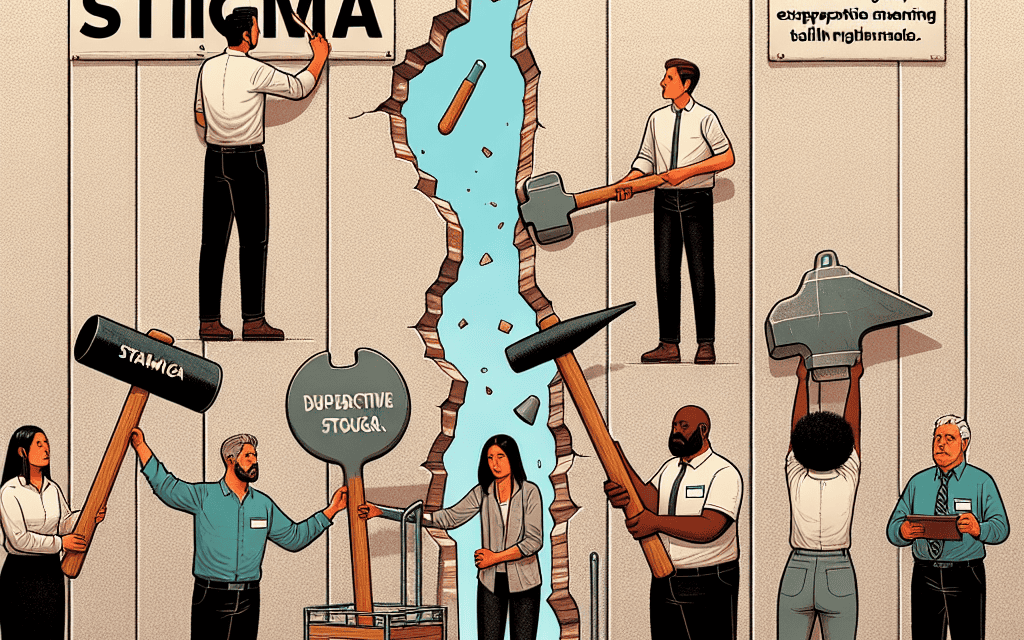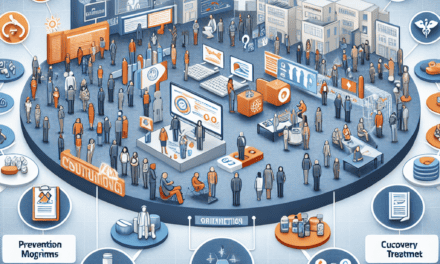-
Table of Contents
- Mental Health Awareness: Breaking the Stigma in the Workplace
- The Importance of Mental Health Awareness in the Workplace
- Understanding Mental Health in the Workplace
- The Economic Impact of Mental Health Issues
- The Role of Leadership in Promoting Mental Health Awareness
- The Benefits of a Mentally Healthy Workplace
- Case Studies: Successful Mental Health Initiatives
- Understanding the Stigma Surrounding Mental Health
- The Origins of Mental Health Stigma
- The Impact of Stigma on Employees
- Strategies to Combat Mental Health Stigma
- The Role of Media in Shaping Perceptions
- Case Studies: Organizations Leading the Way
Mental Health Awareness: Breaking the Stigma in the Workplace

Mental health awareness in the workplace is a critical issue that has gained increasing attention in recent years. As organizations strive to create more inclusive and supportive environments, understanding and addressing mental health challenges is essential. This article explores the importance of mental health awareness in the workplace, the stigma surrounding it, and strategies to foster a more supportive environment for employees.
The Importance of Mental Health Awareness in the Workplace
Mental health is a crucial component of overall well-being, affecting how individuals think, feel, and act. In the workplace, mental health can significantly impact productivity, job satisfaction, and employee retention. Despite its importance, mental health is often overlooked or stigmatized, leading to negative consequences for both employees and organizations.
Understanding Mental Health in the Workplace
Mental health issues can manifest in various ways, including anxiety, depression, stress, and burnout. These conditions can affect an employee’s ability to perform their job effectively, leading to decreased productivity and increased absenteeism. According to the World Health Organization (WHO), depression and anxiety alone cost the global economy an estimated $1 trillion per year in lost productivity.
Recognizing the signs of mental health issues is the first step in addressing them. Common indicators include changes in behavior, mood swings, decreased motivation, and difficulty concentrating. By understanding these signs, employers can take proactive measures to support their employees and create a healthier work environment.
The Economic Impact of Mental Health Issues
The economic impact of mental health issues in the workplace is significant. In the United States, mental health conditions are among the most costly health issues, with an estimated annual cost of $193 billion in lost earnings. This financial burden is not limited to direct costs such as healthcare expenses but also includes indirect costs like reduced productivity and increased turnover.
Organizations that prioritize mental health awareness can benefit from improved employee performance, reduced absenteeism, and lower healthcare costs. By investing in mental health initiatives, companies can create a more resilient workforce and enhance their bottom line.
The Role of Leadership in Promoting Mental Health Awareness
Leadership plays a crucial role in promoting mental health awareness in the workplace. Leaders set the tone for organizational culture and can influence how mental health is perceived and addressed. By openly discussing mental health and encouraging employees to seek help, leaders can create a more supportive and inclusive environment.
Effective leadership involves not only recognizing the importance of mental health but also implementing policies and practices that support employee well-being. This includes providing access to mental health resources, offering flexible work arrangements, and fostering a culture of open communication.
The Benefits of a Mentally Healthy Workplace
A mentally healthy workplace offers numerous benefits for both employees and organizations. Employees who feel supported in their mental health are more likely to be engaged, productive, and satisfied with their jobs. This, in turn, leads to higher retention rates and a more positive work environment.
Organizations that prioritize mental health awareness can also enhance their reputation as an employer of choice. In today’s competitive job market, attracting and retaining top talent is essential for success. By demonstrating a commitment to employee well-being, companies can differentiate themselves and build a strong employer brand.
Case Studies: Successful Mental Health Initiatives
Several organizations have successfully implemented mental health initiatives that have positively impacted their workforce. For example, Unilever has launched a global mental health program that includes training for managers, access to mental health resources, and initiatives to reduce stigma. As a result, the company has seen improvements in employee engagement and well-being.
Another example is the tech company Buffer, which has implemented a transparent approach to mental health by encouraging employees to share their experiences and seek support. This open culture has fostered a sense of community and trust among employees, leading to increased job satisfaction and productivity.
Understanding the Stigma Surrounding Mental Health
The stigma surrounding mental health is a significant barrier to creating a supportive workplace environment. Stigma can prevent individuals from seeking help, lead to discrimination, and perpetuate misconceptions about mental health conditions. Understanding the roots of stigma and how to combat it is essential for promoting mental health awareness.
The Origins of Mental Health Stigma
Mental health stigma has deep historical roots, often stemming from misconceptions and fear. In the past, mental health conditions were misunderstood and associated with weakness or moral failing. These misconceptions have persisted over time, leading to negative stereotypes and discrimination.
Stigma can manifest in various ways, including social stigma, self-stigma, and institutional stigma. Social stigma involves negative attitudes and beliefs about individuals with mental health conditions, while self-stigma occurs when individuals internalize these negative perceptions. Institutional stigma refers to policies and practices that discriminate against individuals with mental health conditions.
The Impact of Stigma on Employees
Stigma can have a profound impact on employees, affecting their willingness to seek help and their overall well-being. Fear of judgment or discrimination may prevent individuals from disclosing their mental health conditions or accessing necessary support. This can lead to untreated mental health issues, decreased productivity, and increased absenteeism.
Moreover, stigma can create a toxic work environment where employees feel unsupported and isolated. This can contribute to higher turnover rates and lower employee morale, ultimately affecting the organization’s success.
Strategies to Combat Mental Health Stigma
Combating mental health stigma requires a multifaceted approach that involves education, awareness, and policy changes. Organizations can take several steps to reduce stigma and create a more supportive environment for employees.
- Education and Training: Providing education and training on mental health can help dispel myths and misconceptions. This can include workshops, seminars, and online resources that promote understanding and empathy.
- Open Communication: Encouraging open communication about mental health can help normalize the conversation and reduce stigma. This can involve creating safe spaces for employees to share their experiences and providing platforms for discussion.
- Policy Changes: Implementing policies that support mental health can demonstrate an organization’s commitment to employee well-being. This can include offering mental health days, providing access to counseling services, and ensuring confidentiality for employees seeking support.
The Role of Media in Shaping Perceptions
The media plays a significant role in shaping public perceptions of mental health. Unfortunately, media portrayals often perpetuate stereotypes and contribute to stigma. Sensationalized or inaccurate depictions of mental health conditions can reinforce negative attitudes and discourage individuals from seeking help.
However, the media also has the power to challenge stigma and promote understanding. By highlighting positive stories and providing accurate information, media outlets can contribute to a more informed and empathetic society. Organizations can leverage media to raise awareness and advocate for mental health initiatives.
Case Studies: Organizations Leading the Way
Several organizations have taken proactive steps to combat





